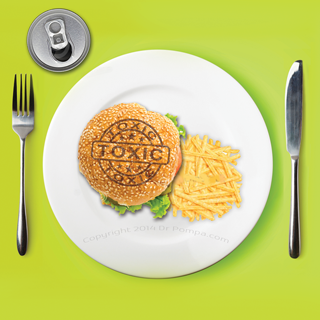Can’t lose weight? You may have toxic heavy metals in your body, hampering hard-earned weight-loss efforts! Read on to learn the connection between heavy metal toxicity and the reason why the scale won’t budge.
A body filled with toxic substances, such as heavy metals, is often confined in a state of weight-loss resistance, wherein the body cannot lose weight. Until toxins are cleared from the body, individuals will struggle to lose weight, regardless of following a strict diet or exercise protocol. Common sources of toxic heavy metals, like mercury and lead, include amalgam tooth fillings, seafood, body care products, cookware, immunizations, and drinking water. Heavy metal toxicity affects individuals at the cellular level, and compromises how well cells function. Considering the onslaught of toxins to which people are exposed today, and the coinciding obesity epidemic, a safe and effective heavy metal detoxification protocol is needed now more than ever before.
A properly implemented heavy metal detox can be the most worthwhile and powerful detox of all, and lasting weight-loss can be attained. However, many health practitioners perform the detox incorrectly, making the process ineffective and even dangerous. Heavy metals are highly difficult to remove from the body, and need to be detoxed in a unique and precise way. I’ve observed that more patients heal from unexplainable illness and achieve lasting weight-loss with heavy metal detox than any other single alternative solution. The proper protocol is invaluable for those suffering from the effects of chronic heavy metal toxicity, some symptoms of which include fatigue, depression, joint pain, digestive issues, and the frustrating state of weight-loss resistance.
Note: Prior to beginning a detox, testing should be performed by a trained practitioner to determine whether heavy metal toxicity is the source of an individual’s inability to lose weight. Once heavy metals are found to be affecting weight and overall health, one can proceed with the detox protocol.
Understanding Weight-Loss Resistance
Toxins like heavy metals affect hormones and create hormonal imbalances that lead to weight-loss resistance. Improved understanding of hormones and their impact on metabolism and weight is critical in winning the war against obesity. Leptin is a hormone that tells the brain to burn fat for energy. If the brain is not receiving the correct message from this hormone, due to toxic overload, then the body will not be able to burn fat for energy. What does this mean? Real and lasting weight loss is not possible when the body is in a state of toxicity, despite following a healthy diet and exercise regime.
But there is hope. Removing toxic heavy metals from the body, coupled with necessary diet and lifestyle changes, will heal and reset the hormonal mechanisms necessary for weight-loss. And the best way to remove the toxic burden is by following the proper heavy metal detox protocol, under the guidance of a trained health practitioner.
Please read my three-part series, “When Detox is Dangerous,” for more information:
- Part One: Cellular and Heavy Metal Detox Done Right
- Part Two: Safe Heavy Metal Chelation and Mercury Amalgam Removal
- Part Three: How to Detox Heavy Metals Correctly and Safely
Heavy Metal Detox: The How-To
Certain metals are given the term “heavy” because they are, in fact, very substantial and challenging to remove from the body. Due to their physical weight and other unique properties, heavy metals can immobilize the body’s ability to detox. Once detox is disabled, heavy metals begin to bio-accumulate in the cells, inhibiting fat loss. Heavy metals also deplete the body’s natural means of detoxification and ability to maintain a healthy body weight. By exhausting detox pathways, toxins buildup and cause the body to become weight-loss resistant.
The key to breaking through heavy metal induced weight-loss resistance lies in the use of chelation therapy. Chelation therapy is a method of removing heavy metals from the body that involves the use of chelating agents. To successfully chelate, and prevent the dangers of reabsorbing toxins, a true chelator must be employed. An example of a true chelator is the dietary supplement DMSA.
Correctly following the oral chelation method for heavy metal removal is relatively inexpensive, and simple enough to avoid toxin reabsorption. However, for a true chelator (like DMSA) to be effective, it must be taken often enough that a sufficient amount of the substance remains in the bloodstream to prevent metals from recirculating in the body, inhibiting detoxification and fat loss. Taking DMSA at the proper time intervals has allowed countless people, including myself, to detox and heal from heavy metal toxicity. It remains the safest and most effective means of removing heavy metals from the body and, as a result, encourages any needed weight-loss.
Yet there is more involved in successful heavy metal detox than simply taking DMSA at the proper times. Matters of cellular function also need to be considered and addressed in the detox protocol, such as the preservation of intracellular glutathione and the protection of DNA. Glutathione is the body’s most powerful antioxidant. Raising and maintaining glutathione is essential to protect DNA, and keep toxins and heavy metals moving out of cells, and initiating weight-loss. Glutathione also protects the brain from circulating metal in the system and removes metal from deeper cellular stores, making it a crucial component of a true detox and key to losing extra pounds.
Real Weight-Loss through True Detox
Before detox begins, the body’s critical detox pathways need to be prepared and restored, which include the liver, kidneys, lymphatic and intestinal systems. The necessary preparation phase denotes the importance of working with a practitioner trained in proper heavy metal detox; if not, the process can be unsafe or simply a waste of time. Once prepared, the pathways must continue to remain open for a successful detox to take place.
When the pathways are ready, detox can begin, which involves cyclical periods of taking DMSA. To start, it is necessary to take DMSA every four hours for at least four consecutive days (including throughout the night), or an on-cycle, so when it is stopped, very little metal will be left in circulation to redistribute in the body. Following the four day on-cycle, metal is cleared from circulation but still remains in deep tissues and cells. A ten day resting period, or off-cycle, then begins. During this time, the metals begin to move from high concentration in the tissue and cells, to lower concentration in circulation. An off-cycle is needed to rest the detox pathways and allow time for the clearing of metals. The off-cycle also allows detox pathways, enzymes, antioxidants, and nutrients necessary for effective and safe detoxification to re-establish in the body. Following the ten day off-cycle, the next four day on-cycle will re-clear additional metals that have moved out of cells and into circulation. Typically after a year of cyclical detoxing, it’s recommended to extend off-cycles to give metals more time to move out of deep tissues.
Raising intracellular glutathione during the four day on-cycle aids the detox process, and prevents metals from crossing into the brain and moving into other cells and tissues. Incorporating a toxin-binding agent into the protocol also helps to prevent metals from making their way to the gut and being re-absorbed during detox. Toxin re-absorption is known as autointoxication, and causes unwanted and dangerous symptoms and inhibits weight-loss, yet remains a common oversight for many health practitioners.
After three months of on-cycling using only DMSA to chelate, a fat-soluble chelator is added to the protocol to expedite metal removal from the brain and promote weight-loss. This part of the detox is called the brain phase, and is when the real “magic” happens and weight-loss starts to be noticed. Mercury in the brain causes major problems and initiates unexplainable illness. Without proper heavy metal chelation, mercury will remain locked in the brain, causing a variety of symptoms such as weight-loss resistance. Studies indicate mercury bio-accumulates over time in the hypothalamus region of the brain and the pituitary gland, areas of the body which control hormones. During the brain phase of the detox, it is safe and effective to support the hypothalamus and pituitary gland; however, supporting them too early triggers the release of metal when the body is not yet cleared or ready and unwanted symptoms arise and weight cannot be shed. Accomplished researcher Dr. Andrew Cutler notes that after six to nine months of the brain phase, symptoms may recur; but, once the phase is passed, a patient’s life begins to change and excess weight will release.
How Long Will the Detox Take?
Many practitioners do not clearly or honestly indicate the length of time the detox process takes to successfully remove heavy metals and shift the body out of weight-loss resistance. Heavy metals take decades to bio-accumulate in tissues, so time is necessary to safely and methodically remove them from the system. On average, the full detox lasts two years, but the time-frame varies greatly depending on the case. If a person discontinues chelation for nine months and lacks symptoms and begins to lose weight, detox may be complete. As stated, after a year, most patients are directed to commence longer off-cycles of DMSA to allow more time for metal to release from deeper tissues. During these breaks, symptoms may resurface, and the needle may become stuck on the scale if an off-cycle is too long. Metals tend to emerge from the body in waves. A successful heavy metal detox requires patience and persistence, but the body does heal itself and lose excess weight once the toxic metals are removed.
Hope for Lasting Change
Heavy metal toxicity is a major source of modern health challenges, especially for those who are experiencing the frustrations of weight-loss resistance. Many spend thousands of dollars on quick-fix products, diets, and exercise programs that provide little improvement to their health, while weight continues to rise. I strongly believe God uses suffering for a greater purpose. Finding the root cause of illness is the initial step in any healing journey, and is true for finding the source of one’s inability to lose weight. First, determine whether heavy metal toxicity is causing health troubles, and then work alongside a practitioner trained in the proper detox protocol. Once true detoxification is performed, whole body healing and lasting weight-loss can be achieved.
For more information on heavy metal detox, please read my three-part series, “When Detox is Dangerous“: Part One, Part Two, and Part Three.








